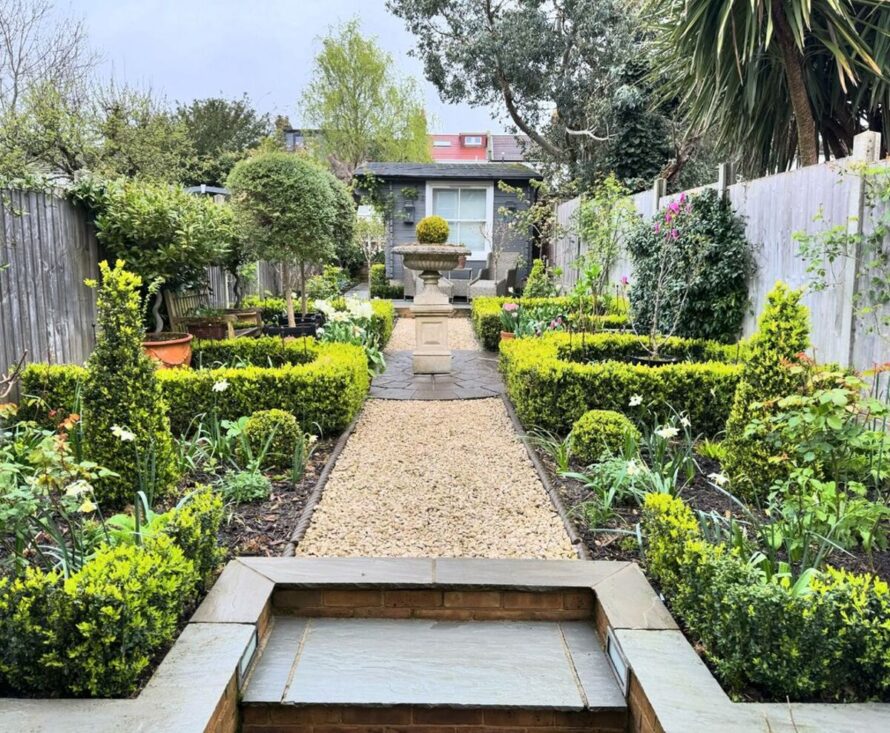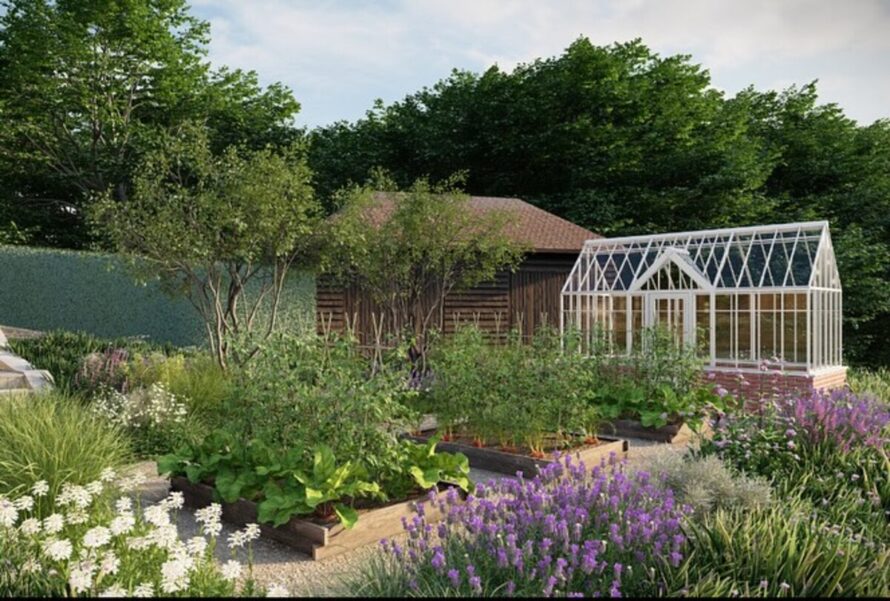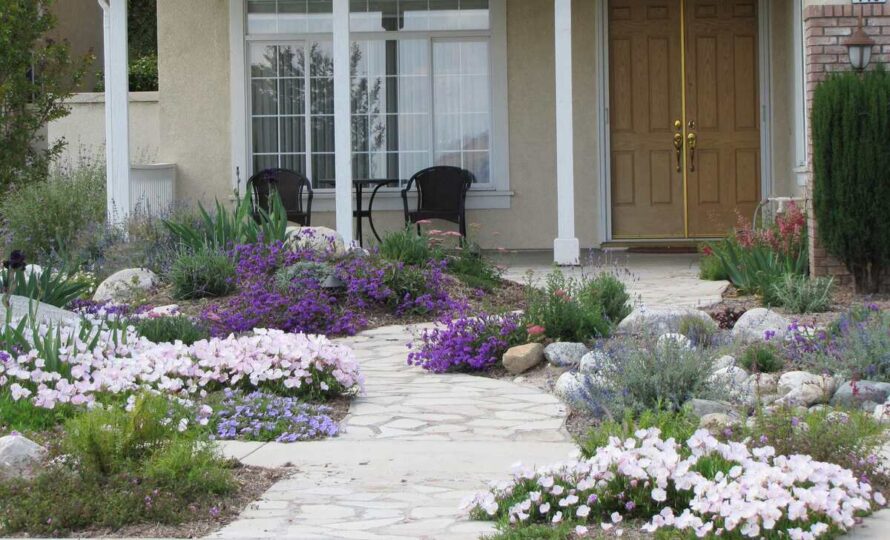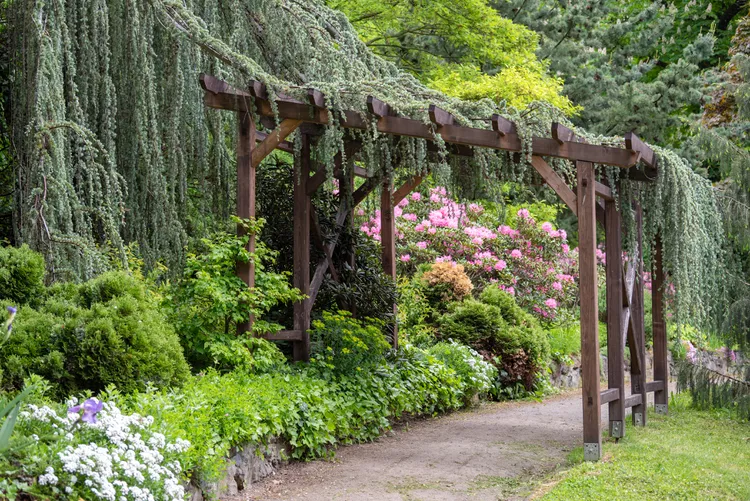Whether you’re planning small backyard garden, a large homestead garden, herb garden, or even a tiny window box garden, referring to garden layout ideas for inspiration can help guide both the blueprint and the types of plants you choose.
Your garden may include layouts like square-foot gardens, raised bed gardens, container gardens, and gardening in rows.
Deciding which one is the best for your garden will include considerations like the best location in your yard, assessing whether it has full sun, partial sun, or partial shade, and matching that up to the best plants for that particular spot.
Often, gardeners will plan the layout around their plants of choice, including tomatoes, potatoes, peppers, fruits, herbs, and flowers.
The plants within a specific garden layout can be chosen based on their USDA Zone and the garden’s sun exposure.
Want to start planning your garden? Here are 30 garden layout ideas to get you started.
Our Top Picks for Your Garden Makeover:
- Raised Garden Beds: These provide a structured and contained space, making it easier to plan and manage different sections of your garden.
- Landscape Edging: Ideal for defining clear boundaries between lawns, garden beds, and pathways, creating a neat and organized look.
- Garden Trellis: Perfect for supporting climbing plants and adding vertical interest to your garden layout, maximizing space and visual appeal.
- Seeding Square Template: This tool helps in precise and organized planting, ensuring optimal spacing for seeds and seedlings for a well-structured vegetable or flower patch.
- Solar-Powered Pathway Lights: Pathway lights are essential for both aesthetics and safety in a landscaped backyard, guiding movement and highlighting features.
- Garden Planner and Journal: A dedicated notebook or planner allows for sketching layouts, tracking plant growth, and organizing garden tasks effectively.
- Fabric Grow Bags: These offer a flexible and portable option for creating garden zones, especially useful for renters or those with limited in-ground planting space.
- Decorative Garden Fencing: Small decorative fences can help delineate specific areas like flower beds or vegetable patches while adding a charming visual element to the layout.
- Garden Stepping Stones: These create an attractive and practical pathway through your garden, guiding foot traffic and protecting plants while enhancing the overall design.
- Outdoor String Lights: These can be used to define and illuminate outdoor living or seating areas within your garden layout, adding ambiance for evening enjoyment.
Timeless Troughs
:max_bytes(150000):strip_icc():format(webp)/TimelessTroughs-13000bcf3b374d5db865d12483528bd8.jpeg)
Stock tanks are readily available at big box and tractor supply stores—and they’re a wonderful way to grow beautiful plants.
Durable and made to last, these containers are a smart option for those who like the charm of troughs, along with the lasting benefits of galvanized steel.
“Thanks to social media, stock tanks have risen in popularity with younger gardeners who want to add a personal touch,” adds McDonald.
RELATED: 35 Unique Container Garden Ideas to Make Your Outdoor Space Pop
Small Space, Big Impact
:max_bytes(150000):strip_icc():format(webp)/SmallSpaceBigImpact-3697a4565034472a96aac10a30aacc27.jpg)
You don’t need a large area to create something truly breathtaking.
“This client inherited the foundation of an English garden and wanted to breathe new life into it with vibrant colors and continuous blooms throughout the seasons,” Janney says.
“Visible from inside the home, it offers a delightful view, showcasing unique blooms in shades of pink, orange, and white.”
RELATED: 50 Clever Small Garden Ideas to Try on a Budget
Border Beauties
:max_bytes(150000):strip_icc():format(webp)/BorderBeauties-91db02f38e8241d6a582396b21b3be02.jpeg)
This layout is just three feet wide and uses the garage as a backdrop for vertical growing.
“Beautiful custom panels add architectural interest and triple the growing area for space hogs like melon and tomatoes,” says McDonald.
“Drip irrigation lines were tied in to ease the stress of watering.”
Kaleidoscope of Dreams
:max_bytes(150000):strip_icc():format(webp)/Kaleidoscope-ee47942996334946bbe19749dcc972ca.jpg)
This garden offers a more woodsy, natural vibe, with bursts of color popping all season.
“We exchanged the standard-looking shrubs for unique shapes that gave the garden more room to breathe,” says Janney.
“Then, we added a variety of colors and plants to bring life to their front yard.”
RELATED: 34 Front Yard Flower Bed Ideas to Boost Your Curb Appeal
Prop Up a Ladder Garden

A repurposed ladder makes the perfect foundation for lots of pots of herbs without taking up a ton of space on your patio or deck.
It also accommodates different sizes of pots and window boxes, as shown here, for a pretty and appealing display.
RELATED: 20 Unique Vegetable Garden Layout Ideas
Gardens Along A Beautiful Walkway

If the backyard is long and narrow, here is a great landscape idea that will upgrade it and will make the most of the space.
A walkway is formed in the middle. It is outlined with pipes and the ground is covered with pea gravel that is easy to maintain and also suitable for this application.
The areas between the ends of the walkway and the fence are covered with flower gardens.
The plant varieties are different to ensure blooming beauty throughout the entire warm period of the year.
The fountain in the middle of the walkway adds a final touch to the elegant landscape.
RELATED: 30 Beautiful Backyard Walkway Examples
Garden Beds And Greenhouse

@pollyanna_wilkinsonstudiopollyannadesign
Check out this lovely garden layout featuring a mix of flowers and vegetables. You can maximize the space by separating the plant groups in garden beds.
It depends on your budget and time if you would make the beds raised as planters or if you will only outline them for an organized and appealing look.
RELATED: 29 Creative Greenhouse Ideas For Gardening Enthusiasts
Water-wise Plants

This front yard garden is divided into sections. Some flower beds are covered with mulch, others with stones to create the final look of a rock garden.
The plants are water-wise varieties, and the soil coverage helps with drainage.
RELATED: 25 Rock Garden Plants for a Colorful Low-Maintenance Garden
Square Foot Vegetable Garden
:max_bytes(150000):strip_icc():format(webp)/spruce-gardenlayoutideas-GettyImagesPhotobyCathyScola-3afbc83eaf954678bd434912f36129ce.jpg) Cathy Scola / Getty Images
Cathy Scola / Getty Images
A square-foot vegetable garden is a great way to organize your garden if you plan on planting a variety of vegetables, fruits, or herbs.
You’ll plant in square-foot blocks rather than the rows that you often see in vegetable gardens.
Within each block, you’ll plant the maximum number of plants that will grow according to that particular vegetable’s guidelines.
For example, you can plant more carrots than you can cabbage within a square foot.
RELATED: 20 Unique Vegetable Garden Layout Ideas
Garden With a Cohesive Color Palette
This townhouse courtyard featured on Home Living Now shows a great way to make space appear larger by keeping the number of colors used to a minimum.
Purple and yellow are complementary colors that work together to make each color stand out, but any color pairing you love would work.
Keep the plants low and loose, to soften the geometric shapes of hardscaping, such as the patio, lawn, and pathway.
Raised Garden Beds
:max_bytes(150000):strip_icc():format(webp)/thespruce-gardenlayout-raisedbeds-15457d07669f4d53bed85bb3fe612bc0.jpg) SbytovaMN / Getty Images
SbytovaMN / Getty Images
If you want a neat, organized way to plant your vegetable garden or want to grow multiple plants that don’t play well together, try raised beds.
This allows you more control over your soil and can save you the task of weeding regularly.
You can make symmetrical raised beds for a more formal look or size them according to the plants you plan on growing.
While they can be DIYed, you can also go for a more structured look like the garden above, where gravel paths make it easy to travel between beds.
RELATED: 29 Raised Bed Designs for Vegetable and Flower Gardens
Perennial Shade Garden
Shade gardens create a wonderfully restful ambiance that works particularly well around patios and decks.
Gladys King, from Hometalk, shows you how she made elegant use of the color green in her shady retreat.Low-maintenance ferns and hostas make up the bulk of the planting.
Be sure to include some with variegated white and gold leaves, to add even more texture to the planting.
Try planting some brighter hosta in a spot where the sun breaks through and watch them glow.
Green contrasts particularly well with darker wood colors such as the decking, the stone and paving, and even the tree trunks.
Inviting Modern Garden
:max_bytes(150000):strip_icc():format(webp)/Lawford-14049818237_38a88d61c7_k-5b293cb43418c6003653acf4.jpg) Herry Lawford / Flickr / CC BY 2.0
Herry Lawford / Flickr / CC BY 2.0
Clean lines and symmetry create a modern style garden.
In the Telegraph Garden, photographed by Herry Lawford at the Chelsea Flower Show, the minimal use of color is very calming and soothing to the eyes.
Create and repeat rounded shapes, such as the clipped boxwood for a relaxed orderly look.
Except for mowing and occasional pruning, very little maintenance is required to keep this space looking fresh and inviting.
Side Yard Garden
Narrow side yards can be a challenge to design.
Using fencing that is made of the same materials as the house creates the walls of a garden room.
Having the structure of the walls makes it easier to outline the way the path should flow.
With these elements laid out, you can use plants as dressing.
Something tall, such as the arborvitae at the curve in the path, keeps the eye from shooting straight past the garden and out the gate.
Low, spreading grasses will make the space seem a bit wider than it is.
RELATED: 28 Gorgeous & Cozy Corner Garden Ideas for Your Backyard
Lush Drought-Tolerant Garden
Limited water doesn’t mean you can’t have a lush, vibrant garden.
Many plants can thrive in dry areas and survive periodic drought conditions.
Succulents may be the first plants that jump to mind, but this xeric garden featured in Roses in Wilson showcases drought-tolerant shrubs, such as rose of Sharon, rosemary, and Russian sage.
Besides plants, choosing a high-contrast light-colored stone mulch will make the limited colors all the more vibrant.
Flower Border Garden
Fran Sorin, at Gardening Gone Wild, provides a perfect example of a classic perennial border, with a billowing, dark evergreen hedge as the backdrop and a progression of plant heights from low in front to tall in the rear.
The mounded plants keep your focus rolling toward the house. These are most effective when accented by clusters of spiky plants at increasing heights.
If you love blue-toned flowers, the use of white and yellow will make blues and purples stand out, rather than recede into the distance.
Japanese-Influenced Garden
The Japanese influence in this garden designed by Ramon Smit and showcased by Paramount Plants goes well beyond the weeping Japanese maple reflecting over the water.
What provides a sense of Japandi style is how meticulously maintained all the shrubs are.
The plants should be perfectly shaped, but look natural.Even the ground coverings need attention to detail.
Instead of grass, use moss and gravel. If you want to include a few flowering plants, make sure they echo the color of the hardscaping.
Monochromatic Garden
Purple is a dramatic color, but at a distance, it tends to fade away. In this intimate space, purple is warm and embracing.
This Hampton Court Flower Show garden is featured by Susan Rushton uses the subtle differences between the shades of purple and the round and spiky flowers to keep it from looking flat.
You can add some contrast, like the white delphiniums, to brighten things up.
An asymmetrical path will lead visitors straight to the focal point.
Entryway Garden
At Pacific Horticulture, Dave Egbert explains that a welcoming entryway garden starts with a wide path to the front door.
Creeping plants, such as fragrant thyme, can be allowed to meander between the flagstones.
Keeping larger shrubs away from the walls isn’t just fire smart, it makes the area appear larger than it is.
Coordinating the bronze tones of the ornamental grass seed heads, succulents, containers, and tile roof ties the whole entrance together.
Ornamental Grass Garden
:max_bytes(150000):strip_icc():format(webp)/Grasses-5b294c7104d1cf0036e7c3e3.jpg)
One of the best low-maintenance plants for any garden is ornamental grass.
The blades and inflorescence add movement and sound to a garden, but perhaps their best feature is the way they glow when backlit by the sun.
This garden was designed by Scott Lewis for a California vineyard explored in Gardenista.The grasses and small trees light up a pathway and invite you to enter.
Use something like an arbor to borrow and incorporate the distant view, the way the hazy mountains here create an atmosphere you could never get with bold-colored flowers.
Enclosed Garden
Whether you have a small backyard or courtyard or you just want to create a space for dining near the house, one of the best ways to close off an area without making it feel claustrophobic is to use lattice.
The Garden Lovers Club found a way to make this compact backyard garden both airy and chock full of plants.
Lattice openings allow air and light to get through, while still providing some privacy. Plants on either side of the lattice walls will give even more screening.
Having the plants and containers in the yard elevated above the sitting area further adds to the sense of airy enclosure.
You can blend the wood tones and gray hardscaping with the use of gray and terracotta-colored ornaments, pots, and cushions.
RELATED: 50 Clever Small Garden Ideas to Try on a Budget
Modern, Functional Garden
Many times, outdoor entertainment areas need to be carved out around a garden, but the folks at Collaborate Decors showcased a garden carved out of the patio.
With the small tree in the center and the large boulders, it looks as though this was a natural part of the site.
Two separate seating areas are created by this division, but the stepping stones keep them connected.
Although a limited number of plants are used, there is enough garden space to soften and cool the look of the stone pavers.
You could create a similar space on an existing patio with raised beds.
Zen Garden
Symmetry and geometry can be very striking in the garden.
Nawawiah at Inspiring Home Decor softened the almost Zen-like quality of the hardscaping in this geometric garden by juxtaposing it with a deep, lush border of soft greens and purples.
This way, you can still have order and symmetry, as here with the alternating standards and hydrangeas and the pair of purple-leaved trees.
The fullness and mounding shapes of the plants will keep your garden from being austere.
Floating Island Gardens
These island beds are overflowing with effusive flowers, but their clean edges keep them from looking wild or messy.
They used this English-style border to inspire this garden.
A natural feel is created by using different size beds, while a sense of cohesion can be maintained by repeating colors and plants, like the airy wandflower and the bold coneflowers.
The two tall evergreens in the large front bed break up the otherwise flat expanse of flowering perennials.
Front Yard Garden
A well-maintained front yard garden makes an immediate impact.
This cottage-style garden at GooDSGN shows how to keep things simple while tying in with the house.
Large shrubs on either side of the garden will add substance and anchor the space.
Bright flowers at the entrance, like these impatiens and hakonechloa grasses are just enough to designate an entry point without looking too busy and overwhelming the house.
And while you want your garden to provide a bit of privacy for you, it’s best not to fully block the view of the house from the street.
RELATED: 20 Beautiful Shrubs to Boost Front Yard Curb Appeal
Small Vegetable Garden
:max_bytes(150000):strip_icc():format(webp)/thespruce-gardenlayoutideas-SantiagoUrquijo-feae77192efd4f86b9741bbb1289e611.jpg) Santiago Urquijo / Getty Images
Santiago Urquijo / Getty Images
Even with just a small amount of space, you can still grow a vegetable garden.
You don’t have to follow the exact measurements of other gardens that grow in rows or squares; instead, you can focus on maximizing your space for the vegetables you want to grow.
Consider planting them based on their growing season so you can easily cycle out plants with each harvest.
RELATED: 20 Unique Vegetable Garden Layout Ideas to Elevate Your Yard
Large Backyard Garden
:max_bytes(150000):strip_icc():format(webp)/creating-a-cottage-garden-1402541-hero-7d060b5189a3415bbf5541905eaf12d0.jpg) The Spruce / Autumn Wood
The Spruce / Autumn Wood
When you have a large backyard to work with, you can create two distinct spaces.
One is the lush green lawn that’s perfect for throwing out a picnic blanket. The other is the abundant border that can include trees, ground cover plants, seasonal flowers, bushes, water features, and hardscaping.
All this space gives you room for creativity, color, and texture. Let the shape of each space feel organic and flowing.
There’s no need for a strict square. Instead, it can move around the yard.
Vertical Garden
:max_bytes(150000):strip_icc():format(webp)/Pallet_CU_DSC_1966-5701b5823df78c7d9e653821.jpg)
The Spruce / Kerry Michaels
If you’re short on square footage, go up! A vertical garden offers flexibility for those in small spaces.
You can try succulents, herbs, vegetables, or flowers. In this garden, a scattered effect plays off of the colorful backdrop.
But, in a more minimalist vertical garden, you could focus on straight, symmetrical rows.
RELATED: 31 Creative Vertical Garden Concepts for Any Space (Indoor/Outdoor)
Herb Garden in Terracotta Pots
:max_bytes(150000):strip_icc():format(webp)/spruce-gardenlayout-Westend61-ae6c01ffc17e41e599e5e2cc79b047e9.jpg) Westend61 / Getty Images
Westend61 / Getty Images
Herbs thrive in a container garden, and they have a classic look when planted in simple terracotta plants.
This gives you the flexibility to plant multiple herbs in one spot, even when they have varying water requirements.
Stack them in a way that lets you get more light to herbs like rosemary or thyme while giving others, like cilantro, a shadier spot.
Formal Rose Garden
:max_bytes(150000):strip_icc():format(webp)/spruce-gardenlayout-brytta-955f0db8f8ac49f7b00e09f7b5a981be.jpg) brytta / Getty Images
brytta / Getty Images
A formal rose garden is one of the most iconic garden layouts.
With a pebble gravel path, hedge border, and overflowing rose bushes, it has the abundant feel of an English garden, but with a more tailored look.
It’s a straightforward layout to follow—just plant the hedges in a straight shape and fill the area with rose bushes.
Mixed Herb, Vegetable, and Flower Garden
:max_bytes(150000):strip_icc():format(webp)/thespruce-gardenlayout-fotolinchen-f1acbbc25ee74af29c25d8a323a1f3a1.jpg) fotolinchen / Getty Images
fotolinchen / Getty Images
Herbs, vegetables, and flowers can all grow beautifully right next to each other, and they give a garden with rows a more casual look.
Plant the flowers on the border to help repel pests and attract pollinators, then plant herbs and vegetables—paying attention to good companions—throughout the garden beds.



:max_bytes(150000):strip_icc():format(webp)/Townhouse-5b293e4bff1b7800371788a2.jpg)
:max_bytes(150000):strip_icc():format(webp)/Hometalk-Shade-5b4f3a4046e0fb003780182b.jpg)
:max_bytes(150000):strip_icc():format(webp)/SideYardPath-5b293de6119fa80037b425ad.jpg)
:max_bytes(150000):strip_icc():format(webp)/RosesinWilson-5b4f30e5c9e77c003763af3d.jpg)
:max_bytes(150000):strip_icc():format(webp)/Sorin-5b294b1a3418c6003656761f.jpg)
:max_bytes(150000):strip_icc():format(webp)/Japanese-5b294db5fa6bcc0036ff4723.jpg)
:max_bytes(150000):strip_icc():format(webp)/Rushton-5b294bb98e1b6e003e3f6fc7.jpg)
:max_bytes(150000):strip_icc():format(webp)/PacificHort-5b4f36b246e0fb005b9d7084.jpg)
:max_bytes(150000):strip_icc():format(webp)/Lattice-5b294cb4ba6177005459491a.jpg)
:max_bytes(150000):strip_icc():format(webp)/DeckCutout-5b294d05303713003708948f.jpg)
:max_bytes(150000):strip_icc():format(webp)/Geometric-5b294d6c3418c6003656d907.jpg)
:max_bytes(150000):strip_icc():format(webp)/Islands-5b294e178e1b6e003e3fd3f2.jpg)
:max_bytes(150000):strip_icc():format(webp)/GooD-Privacy-5b294fa33128340037e671e6.jpg)
I am intrigue: I was unaware that gardens could display such beauty, serenity, and wellbeing… going through these different gardens, gives me a sense of belonging to nature, and fulfilling earth’s nature to the fullest: I am not only intrigued, but now I am set in getting professional help to create gardens with different colors, purposes that help nature fulfill here destiny of beauty